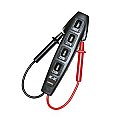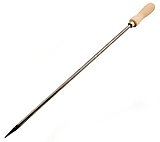Line Voltage Tester - TE101
Tool Experts Line Voltage Tester TE101 Circuit Tester checks voltage from 80V to 500V AC/DC 1/4 Watt. Heavy-duty test probes, bright neon AC/DC indicator, pocket clip and insulated casing.
Tool Experts Line Voltage Tester TE101
Line Voltage Circuit Testing:
3 Wire AC Grounding Outlets and Cords:
Insert probes into narrow (hot) and wide slot (neutral) of receptacle, tester will glow on the live circuit. To check grounding, insert one probe into the narrow (hot) side and the other into “U” shaped (ground), tester should glow. Then test between wide side (neutral) receptacle.
2 Wire AC Outlet and Cords:
Insert probe into both sides, tester will glow on live circuit. To determine hot wire on 2 wire circuits, insert one probe into the narrow slot and touch other probe to the metal mounting screw or metal plate. If screw is grounded, tester will glow. Remaining slot is the grounded (neutral) receptacle.
3 Wire 220V AC Receptacles:
Test for normal (110V) glow test round hole (neutral) and either hot side. Observe brighter glow (220V) across both hot sides.
Line Voltage Tester Operating Instructions:
To test for voltage insert leads into the outlet or carefully touch the test leads to electrical contacts or circuit to be tested.
If voltage is present the neon indicator will glow. To test for live side of an electrical outlet insert one probe into the ground plug of the outlet while inserting the other probe in the alternate sides of the outlet. The neon indicator will glow when the probe makes contact with the live side.
Circuit Tester Specifications:
Working Voltage Range: 80-500V AC/DC
Frequency: 50/60 Hz
Relative Humidity: 80% RH max. 50% RH above 31 degrees C
Pollution Degree: 2 (accordance with IEC-664)
Note: Voltages less than 8.0 volts may not be detected by this tester, although they may be present.
-
Working Voltage Range:80-500V AC/DC
-
Frequency:50/60 Hz
-
Relative Humidity:80% RH max. 50% RH above 31 degrees C
-
Pollution Degree2 (accordance with IEC-664)
Product questions
-
01/27/2021, 07:59 AM
sirs, Is there anything out there that we could use that is simple for line workers in a factory setting that would check not just spark but maybe catch weak spark? green light red light for simplicity. Any ideas would be great! Thanks, R.Vinge
01/27/2021, 09:37 AMIf you are looking for AC current the santronics will detect voltage down to 50 volts. If this is not what you are looking for give us a call at (865)882-3833
https://www.toolexperts.com/voltage-detector-sensor-for-ac-non-contact-detection.html -
11/30/2020, 11:56 PM
when there is no ground or neutral present and you are testing for hot only. older inexpensive testers you were able to put your finger on one probe and the other to the hot wire, it would give you a dim neon light letting you know power was present. they work well with testing ungrounded romex or knob n tube where no neutral or ground is present. i purchased one tester recently and it did not work finger to hot the way I've bin testing for 40 years
12/01/2020, 08:41 AMFor your situation I would recommend just getting a voltage detector like the one here: https://www.toolexperts.com/voltage-detector-tester-ac-dc-low-non-contact-volt-meter/voltage-detector-sensor-for-ac-non-contact-detection.html
-
05/04/2020, 07:42 PM
What is the proper way to use the two wire voltage tester? Where do
I place the thin metal probes?05/05/2020, 10:37 AMTo test for voltage insert leads into the outlet or carefully touch the test leads to electrical contacts or circuit to be tested.
If voltage is present the neon indicator will glow. To test for live side of an electrical outlet insert one probe into the ground plug of the outlet while inserting the other probe in the alternate sides of the outlet. The neon indicator will glow when the probe makes contact with the live side.














